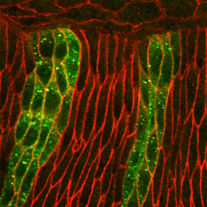Research
Cell diversity: The generation of specific cellular architecture

Our fully developed body consists of more than 200 cell types that differ considerably in the two intimately linked variables, shape and function. Additional cell diversity is generated during the different stages of embryogenesis, when many, if not most of our cells reversibly change their architecture in order to fulfil transient developmental functions or to divide. Our goal is to uncover the molecular mechanisms that generate diversity in cell morphology. We are particularly interested in the role of the cytoskeleton and of specialised membrane domains. Knowing the critical differences in the relevant molecular processes may allow selective manipulation and targeting of abnormal cells. An intriguing point to consider is that highly divergent organisms such as human and flies share many cell types, like for example neurons or muscle cells, with an amazing architectural conservation despite the significant genome differences. This suggests that conserved principles and rules apply to generate particular cellular architecture and function.
In our attempt to uncover such principles we use two very different model organisms, the fruit fly Drosophila melanogaster and the fission yeast Schizosaccharomyces pombe. The cylindrical cells of the fission yeast provide a powerful experimental system with which we can easily study the molecular processes mediating cell morphogenesis in fully autonomous living cells. In fruit flies we build on the results obtained in fission yeast and study the respective cell biological problems in a multicellular environment where collective effects and signalling activities need to be considered.
In our studies we combine modern real-time fluorescence imaging of the living organism with classical genetics, molecular biology, biochemistry and biophysics approaches. Quantitative data analysis is a central tool that we use to describe the dynamics and behaviour of our cellular systems in the wild type and in mutants. Where possible we use these quantitative data to develop mathematical models, which we can use for further “in silico” exploration of the mechanisms driving the system. Consequently, many of our projects are highly collaborative and interdisciplinary.